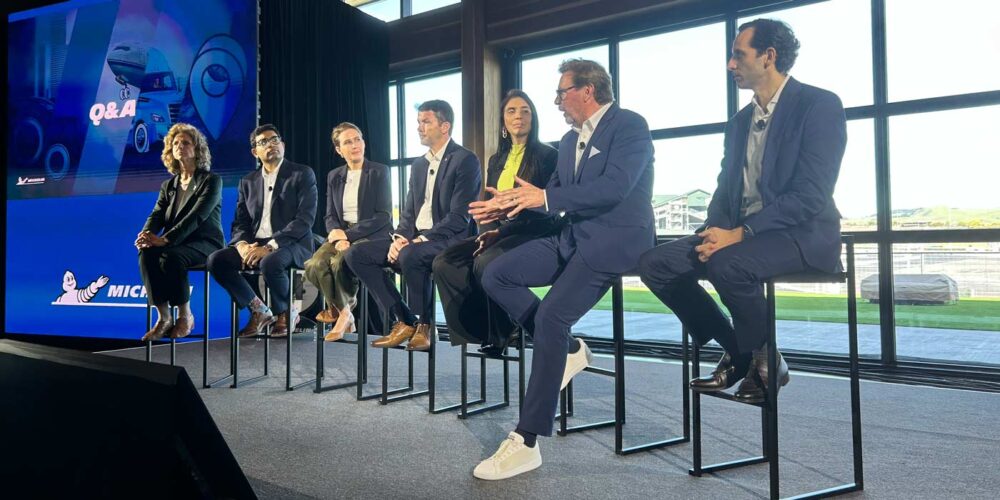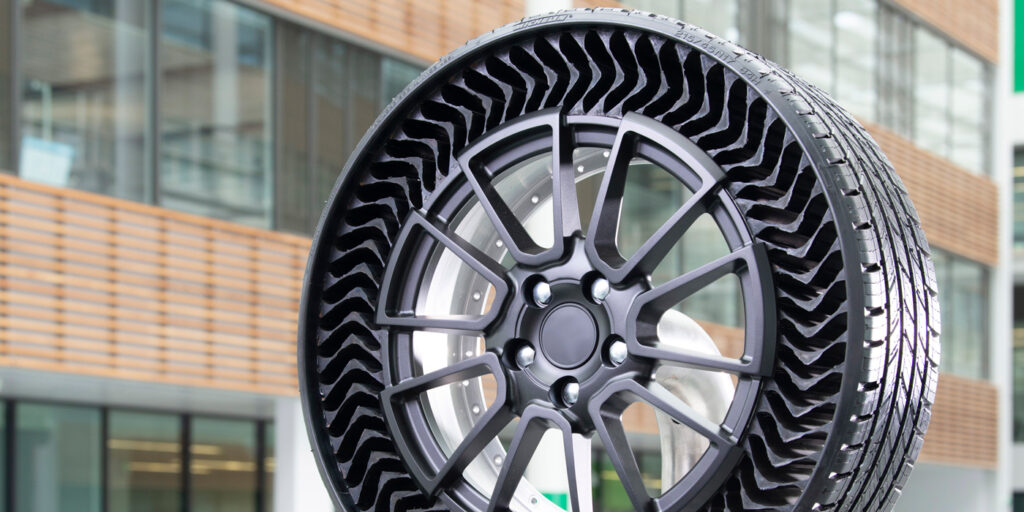During Michelin’s Sustainability Summit held at the Sonoma Raceway in California, Michelin North America’s president and CEO, Alexis Garcin, explained how the company plans to reach its goal of manufacturing tires made from 40% renewable or recycled materials by 2030, and 100% renewable or recycled materials by 2050.
The company invited Tire Review to pepper members of its executive leadership team with questions regarding the future of sustainable tire manufacturing, the relationship between EVs and tire waste, what’s next for airless tire technology and even how Michelin automotive tires influence other tire verticals, like aviation tires.
How is manufacturing a tire for electric commercial vehicles different than when designing tires for light-duty electric vehicles?
Pierluigi Cumo, vice president of business-to-business products: I can’t speak for B2C, but I think from our perspective we try to evolve the tires so they aren’t completely different tires. It’s more enhancing the performance characteristics of the tire to meet the needs of the vehicle and the application, and the manufacturing and everything tied to that evolves with it.
Nathália Hasselmann, plant manager of Michelin’s passenger car tire facility in Greenville, SC: It’s not only about the different types of materials that go inside the tire. It’s also the architecture of the products inside the tire that makes a big difference, as well as the process.
Cyrille Roget, scientific and innovation communication director: That’s a characteristic of Michelin tires – from one to the other, week after week, month after month, you will always have the same performance. It’s very important to make sure that when you produce a tire, each has the same performance has the next because it’s also part of our promise that when you buy a tire two years after you bought the original one, it still has exactly the same performance as the one you bought two years ago. Our capacity to always reproduce the same performance is something that sets us apart a lot of time from our competitors.
One thing that is funny about materials is that when you want to improve safety, you want a material that sticks on the road, but if it sticks on the road it will also stick to your tools. There is a lot of investment from our people in our plants and from our industrial people working with our R&D team to make sure that we improve the process so that when we create the material in the plant, it won’t stick everywhere.
Do you have any insight on the effect EVs have on creating tire rubber particulate emissions? Is Michelin concerned with this or addressing this in any way?
Cyrille Roget, scientific and innovation communication director: What we know for sure is that the relation between the weight and the average rate of wear is one-to-one. So, for example, if you have a vehicle that is 10% heavier compared to the other one, it will have a rate of wear that is 10% higher. [To address this], we have have been working for many, many years to develop a better product with less material because it’s our DNA to provide more performance with less material. That has led us to develop tread compounds that are much better in terms of resistance to abrasion. There was study that was published in Europe [that positions] Michelin as the leader in terms of performance and in terms of emissions or resistance to abrasion per kilometer driven.
Michelin has said that EV tires could impact the vehicle’s range by 40 miles per charge. Is there potential for this number to increase?
Alexis Garcin, president and CEO, Michelin North America, Inc.: I wish I could answer that question precisely, but I can’t because there are many, many factors that are impacting the range of the car. What we know today is that we can tell there is a difference up to 40 miles. This is a fact.
But, what does that mean five years from now? It all depends on what kind of car we’re talking about. What is the weight? What is the performance? There are a ton of factors influencing that, so it’s difficult for us to project. What we really believe is that there will remain one critical factor to improve or to maximize the range of the car. This is maybe the most factual way to project that information for the coming five years.
In attempting to develop 100% renewable or recycled material tires, what materials are giving you the most trouble?
Cyrille Roget, scientific and innovation communication director: You have several challenges when you change a material. The first is to be able to obtain a material that has the same quality as the fossil material that you’re trying to replace. Frankly, technologically, the performance that we have in our different technologies are at a mature level, so we know that we can replace the fossil material with something of the same performance level. The problem is the feedstock. For some technology, for example, plastic bottles that will serve as the reinforcement for our passenger car tires to replace the PT from fossils, the problem is how you organize the collection of all the plastic bottles as a feedstock in the future. Another challenge is to be able to grow the material in terms of production level to reach the same cost level as the fossil material.
The technologies and materials that you see us using here are recycled steel, recycled carbon black coming from end-of-life tires, silica coming from rice husks, natural rubber, and some natural resin and oil that are coming from orange peels and things like that.
The specification we have given designers was to use only materials that improve the lifecycle analysis, will be ready for mass production in 2025, and do not degrade tire performance. That’s why those tires have exactly the same performance. They don’t degrade the performance of the tire. They will be available on our side commercially to put in our tires on an industry level in 2025, which feels like tomorrow in terms of tires. And, of course, they improve the environmental impact of the tire.
What metrics are you using to determine that a tire has the same performance while using different materials?
Cyrille Roget, scientific and innovation communication director: The main performance we talk about is safety. Safety is usually very easy to measure – it’s breaking distance on dry roads and wet roads. We measure this on when the tire is new as well as when the tire is at its worn limit to make sure that the tire will be safe during its entire life.
We also measure longevity, because this has a direct impact on how many tires you need for the life of your vehicle. Of course, we must also determine the energy efficiency of the tire, meaning the rolling resistance. That is measuring kg/ton, but this is very important because it has a direct consequence on fuel consumption, as well as the range of your electric vehicle. After all of that comes noise and comfort. We have a set of specifications that are measured on machines or by our test drivers on the track.
Do you have any updates on airless tire technology? Does Michelin have a rollout plan for this technology?
Cyrille Roget, scientific and innovation communication director: Firstly, we are convinced at Michelin that airless is the future of tire technology, and that is necessary for many reasons.
One is that around the world, about 20% of all tires today are dismounted prematurely. They have not gone through their whole service because they have damage on the sidewall, or maybe they had a puncture and they had to be replaced. With that 20%, if you consider that today around 1.6 billion tires arrive at the end of life every year around the world, that’s almost 300-320 million tires that potentially could have potentially been saved by airless technology. So, we are convinced that it’s a technology that is really useful in our approach to sustainability.
We have a technology that we have put into the market and commercialized today known as the tweel. It’s made in South Carolina in our plant for specific applications which are mainly low-speed and low-load vehicles. But we knew the technology was not enough. That’s why we have worked on different technologies. We have invented a new material to put into that technology, and we are able to reach a level of performance that is very close to modern styles today. That technology has been tested by Michelin internally on different roads around the world. We have also put more than 2 million miles today on Uptis tire testing. It’s still a prototype, keep that in mind; we are not permitted to drive on-road, and we have to have a specific delegation to be able to place those tires on the market.
We have two contracts today that started in 2023, one with DHL in Singapore for last-mile delivery and another with La Poste, which is like the United States postal service, but in France. [Between these we] will have about 50 vehicles that will be equipped with Uptis tires. The idea is to run those for two years to be able to capture as much data as we can.
We have 130 years of background, so we know everything about tires, but airless technology is completely new in terms of design, in terms of production, and in terms of formal obligation. We have to learn everything we can, and this is why we have those two years of placement to test with DHL and La Poste up until the end of 2025.
The development for these tires at the moment is in the U.S. at our research center in Greenville, as is the production today of the Uptis tires that will go on the vehicles in the DHL and La Poste.
How does Michelin use what it has learned from automotive tires for other verticals, such as aviation? How does that intersection apply to a more sustainable or environmentally conscious product?
Cyrille Roget, scientific and innovation communication director: I have had the privilege of working both on the passenger car side and the aircraft side for almost 10 years. The intersection is mostly in material development because really you must understand that everything we do at Michelin is with understanding the different properties of the material and the composite that we create to make tires, whether it’s passenger car or aircraft.
In terms of usage, a tire that goes an Airbus or Boeing will carry almost 30 tons per tire, inflated to 235 PSI. It’s very different from a passenger car tire, but either way, the fact is that you have to design the tire to be able to carry its load at a certain pressure.
So the common point [between automotive and aviation tires] is the tires are the only point of contact between the road or the tarmac and the vehicle. So, the main intersection for us is around understanding how we can develop better material in the different applications. The material development that you are seeing here in terms of being able to change materials with renewable and recycled materials will apply to all our tires.
Of course, the technology and the final material that will be chosen in its formulation for an aircraft is different from the one that you will find on the passenger car. But, the people who are working to develop the new composite are the same people basically at the beginning. It’s just the assembly at the end that is different.
Alexis Garcin, president and CEO, Michelin North America, Inc.: There is another intersection between our truck and bus activities and our aviation activities because both tires are being retreaded. That’s a way to maximize the lifetime of the casing.















